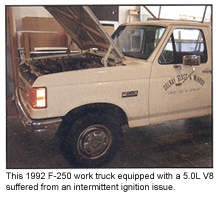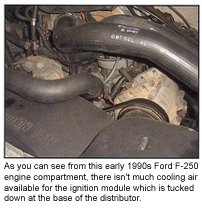One of the finer lines to walk in the service and repair industry is how deep in the mud you’re willing to get when a customer brings in a vehicle with an intermittent driveability problem.
An intermittent surge with a vehicle that is driven once a week is one thing. An intermittent stall on a work truck, like an early-to-mid ’90s Ford truck, is quite another. This is particularly true when the owner of the work truck can’t substitute a rental vehicle into the fleet and demands a “fair” price to get his vehicle back to a reliable state of tune. And, lest we forget, he needed it done yesterday because he has work to do.
 The subject of invoice pricing versus services rendered can spark more rage and debate than the war in Iraq. The key to securing the customer’s business is “honesty” and “options.” If you’re honest with your customers regarding the work that is involved, they will appreciate it. If you give them all of the available options, they will be able to exercise choice.
The subject of invoice pricing versus services rendered can spark more rage and debate than the war in Iraq. The key to securing the customer’s business is “honesty” and “options.” If you’re honest with your customers regarding the work that is involved, they will appreciate it. If you give them all of the available options, they will be able to exercise choice.
There’s an old marketing adage that goes something like, “People will always shop by price alone unless you give them reason to do otherwise.” I like that saying, because basically it means that if I educate my customers and am open and honest with them, I may have an edge on the dealer in these instances. I find that the best way to approach these “time-is-of-the-essence” intermittent problems is by following four simple steps.
Educate the customer on the basic operations of the powertrain system.
Inform them of the “shotgun” approach, and all of the risks involved.
Let them know what it takes to test the powertrain functions and how much time it takes.
Let them decide, then and there, if they are willing to pay your price for initial diagnostic services, or if they want to go with the shotgun approach, or some combination in between.
 Educating the customer is simply a matter of explaining the basic theory of the problem at hand. In the case of an intermittent engine stall, the problem will typically lie in the ignition or fuel system. Along with this, I explain the function of the crank and cam sensors as well. Some customers may not want to hear this bliz-blaz, but they must understand these basics so that they can make an informed decision. If they defer purely to my judgement, I explain that my invoice is non-negotiable. Usually the words “non-negotiable” spark some interest, which is great. It’s what allows us all to understand the full nature of the problem. And it’s only fair.
Educating the customer is simply a matter of explaining the basic theory of the problem at hand. In the case of an intermittent engine stall, the problem will typically lie in the ignition or fuel system. Along with this, I explain the function of the crank and cam sensors as well. Some customers may not want to hear this bliz-blaz, but they must understand these basics so that they can make an informed decision. If they defer purely to my judgement, I explain that my invoice is non-negotiable. Usually the words “non-negotiable” spark some interest, which is great. It’s what allows us all to understand the full nature of the problem. And it’s only fair.
I understand and appreciate the customer’s dilemma, which is that he needs his work truck immediately, and it has to be reliable. It’s only fair that he understand my dilemma and the conflict that exists with what is asked of us technicians in these cases.
So, together we quickly discuss the components that may be defective and what other potential problems may exist. Using a schematic helps in these situations; it also serves to underscore the complexity of the system for the customer.
Following this 10-minute crunch-clinic is an explanation of the shotgun approach and the risks involved. I liken it to the lottery. Pay your money and see if we hit the jackpot. I use my experience to give my customers a percentage chance of success in hard cases. I also tell them this is the least preferred method. It’s unscientific and ambiguous, and worse still, you may temporarily solve the problem by eliminating a defective component, but what if there is a larger root problem or underlying cause for the component failure? What then? I do everything possible to steer the customer clear of the shotgun approach.
The Whole Package
Letting the customer know what is involved in testing the system is a reasonably quick affair, as they have received the bulk of the education from step one. The important point here is that they clearly understand the time involved to test, and the potential outcome.
One major benefit the customer can get from you that they don’t typically get from the dealer is what I call “The Package.” The Package is a group of scope print-outs and voltage/current measurements that I take of all of the vehicle’s vital signals. Fuel injectors, ignition primary and secondary waveforms (voltage and current), crank and cams sensor signals, fuel pump relay operation, fuel pump current draw, etc. Of course, the list changes with the vehicle, but it’s usually quite thorough.
You can make some mechanical and visual checks such as fuel pressures, vacuum hose condition, wire harness, battery cables and battery condition, etc., and add that to the contents of The Package. The Package is the customer’s to keep. I tell them to keep it in the vehicle for two reasons. One, it reminds them of what they paid for. Secondly, and far more important, if the vehicle stalls out of town, it may not be my garage servicing the vehicle. At least the next tech dealing with this problem has a base from which to start. He can compare what he has with what we had when the vehicle ran.
Naturally, you should keep a copy of The Package, for if the vehicle does come back to your shop and you’re not around, your fellow techs know where to find this information if the customer has lost his copy (surprisingly often). An additional benefit for you is that you build your own waveform library and have sample known-good measurements within easy reach when you need them.
1992 Ford F-250
Back to our Ford truck, we had a 1992 F-250 with a 5.0 V8. The TFI modules on these trucks suffer a tough job when mounted on the distributor. There isn’t much cooling air available with the ignition module tucked down at the base of the distributor. Later models had the TFI module mounted separate from the distributor on a nice slab of heat sink.
For work trucks that tend to idle long and often, I usually suggest to the customer that we change the system to remotely mount the unit on a heat sink. This is an easy modification and may save your customer some serious headaches in the future.
Knowing that the ignition module is the weak point in this system due to thermal problems, it’s usually the first place I check when sudden stalling problems occur. Figure 1 shows the PIP signal and the SPOUT signal running simultaneously on the scope. Notice the phase relationship between the two. This phase relationship is the timing advance.
PIP is short for “Profile Ignition Pick-up.” SPOUT is short for SPark OUTput. The PIP signal is generated by a Hall-effect switch located in the distributor. The switch is interrupted by a profiled shutter vane. For the V8, there are seven equal-sized vanes and an eighth vane that is smaller in size. When the Hall sensor detects the smaller vane, the PCM understands that the #1 cylinder is 10








